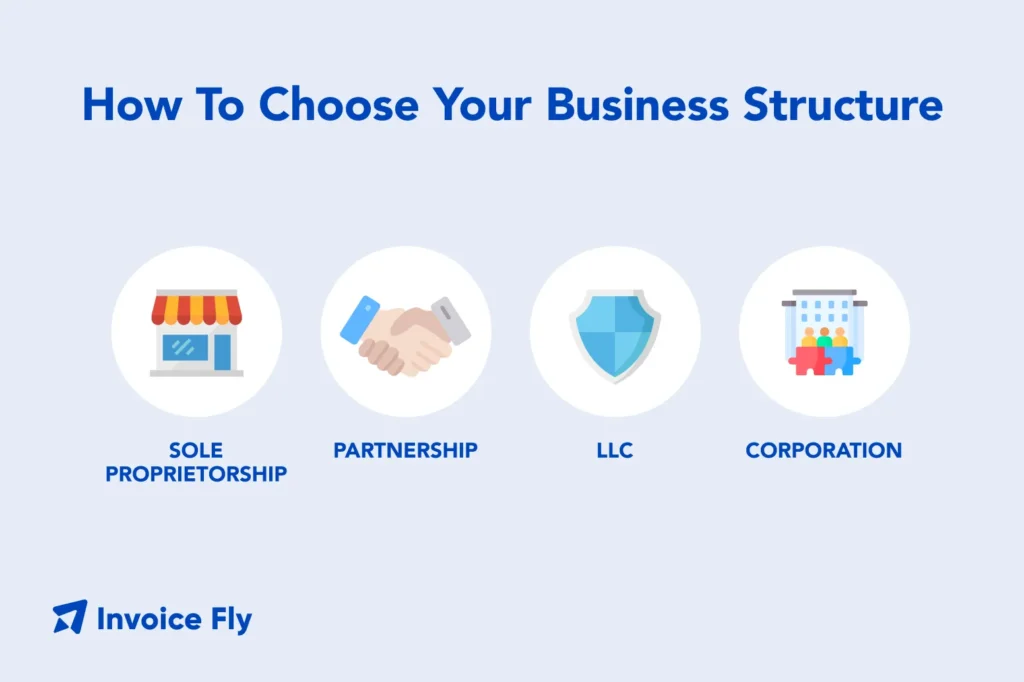How To Choose Your Business Structure: 2025 Step Guide

Table of Contents
Choosing the right business structure is a critical step for anyone looking to start a business in the United States. It affects your taxes, personal liability, ability to raise capital, and even your day to day operations. Small business owners need to carefully consider the advantages and disadvantages of each type of business and legal structure to make an informed decision that aligns with their long-term goals, business plan, and organizational structure.
Whether you’re a sole proprietor launching a small consulting firm or exploring forming an LLC to protect personal assets, understanding the differences between entities will help you avoid costly mistakes.
This guide will walk through:
- Common business structures
- Key features
- Factors to consider when choosing a business entity
- Tax implications and liability concerns for each legal structure
- Advantages and disadvantages of each type
Review Common Business Structures

When you start a business, state laws in the United States require you to register a business entity in most cases. Each type of business offers different levels of liability protection, administrative complexity, and tax treatment.
Sole Proprietorship
A sole proprietorship is the simplest form of business. It does not create a separate legal entity between the owner and the business.
Key points:
- Easy and inexpensive to start; many states do not require formal registration beyond a local business license.
- Profits and losses are reported on your personal tax return (Schedule C).
- Unlimited personal liability for business debts and tax liabilities.
Example: A freelance photographer in Florida operating as a sole proprietor earns income by selling portrait sessions. If a client sues for damages during a photoshoot, the photographer’s personal savings could be at risk.
Tip: Some states require a “doing business as” (DBA) filing if the name differs from the owner’s legal name.
Additional reading: How Solopreneurs Can Build a Business Empire in 13 Steps in 2025
Partnership

Partnerships are businesses owned by two or more individuals. Common forms include:
- General Partnership: All general partners share management duties and unlimited liability.
- Limited Partnership (LP): At least one general partner has unlimited liability; limited partners have liability up to their investment.
- Limited Liability Partnership (LLP): Provides limited liability to all partners, often used by professional service firms.
For partnerships, understanding risk management is vital. Review Do Small Businesses Need Insurance in the US? 2025 Guide to protect against unexpected liability.
Advantages and disadvantages:
- Easy to establish and combine resources.
- Pass through entities for tax purposes; income and losses flow to partners.
- General partners remain personally liable for debts.
Example: Chefs in California open a bakery as a general partnership. One invests cash, the other manages day to day operations. If a supplier sues over unpaid invoices, both partners’ personal assets are exposed.
For more detail and specific state laws check out: IRS Partnerships Overview

Limited Liability Company LLC
Limited liability companies (LLCs) combine the liability protection of a corporation with the simplicity of pass-through taxation.
Pros:
- Members are not personally responsible for debts; the LLC is a separate legal entity.
- Profits typically pass through to members’ personal returns.
- Fewer compliance requirements than a corporation.
Cons:
- States require annual filings and fees.
- Certain states impose franchise or excise taxes.
- Raising outside investment can be more challenging than for a private limited company or corporation
Example: A small e-commerce brand in Texas selling products nationwide forms an LLC. When a defective product leads to a lawsuit, only business assets are at risk, not the owner’s home or personal bank account.
Tip: Fees and reporting vary by state. For instance, California LLCs pay an annual $800 franchise tax.
Corporation
Corporations are separate legal entities with strict governance rules and a board of directors overseeing major decisions.
C Corporation
- Subject to corporate tax; profits may be taxed twice (corporate level and shareholder dividends).
- Unlimited growth potential with stock issuance.
- Strong liability protection for shareholders.
Example: A tech startup in Delaware forms a C Corp to raise venture capital. Investors prefer this type because shares are clearly defined and transferable.
S Corporation
- Pass through entity that avoids double taxation.
- Limited to 100 shareholders and US citizen/resident restrictions.
- Requires filing IRS Form 2553 for election.
Example: A family-owned plumbing company elects S Corp status to reduce self-employment tax while maintaining liability protection.
Benefit and Nonprofit Corporations
- Benefit corporations pursue social missions alongside profit.
- Nonprofits can qualify for federal tax-exempt status under IRS 501(c)(3) but must comply with strict state and federal reporting.
Need a simple way to handle invoices while focusing on your new business structure? Try Invoice Fly’s Invoice Maker to manage billing, payments, and clients in one place.
Combine Different Business Structures
Some small business owners choose hybrid structures. For example, forming an LLC and electing S Corporation tax status can reduce self-employment taxes.
Example: A husband-and-wife real estate team in New York forms an LLC for liability protection and later elects S Corp status to save on payroll taxes.
Tip: Check both federal and state rules before electing hybrid status. Some states require additional forms or annual fees.
Compare Business Structures
| Structure | Liability | Tax Treatment | Complexity |
| Sole Proprietorship | Unlimited | Personal (Schedule C) | Very Low |
| Partnership (General) | Unlimited for GPs | Pass through entities | Low |
| Limited Liability Company | Limited | Pass through or corporate | Moderate |
| Corporation (C Corp) | Limited | Corporate tax + dividends | High |
| S Corporation | Limited | Pass through | High |
State-specific note: Fees and filing obligations vary widely. For instance, forming an LLC in Wyoming is inexpensive, while California has high annual franchise taxes.
Choosing Your Business Structure: What to Consider
Risk to Personal Assets
High-risk industries like construction or health services usually benefit from forming an LLC or corporation to shield owners from lawsuits.
Tax Liabilities
Decide whether you want pass through entities or corporate taxation. For example, a C Corp in New York pays corporate tax and shareholders pay again on dividends.

Management and Day to Day Operations
Corporations require a board of directors, formal bylaws, and recorded meetings. LLCs and sole proprietors enjoy flexibility in daily decision-making.
Administrative Complexity
Sole proprietorships and single-member LLCs require minimal paperwork, whereas corporations must file annual reports and adhere to state-specific recordkeeping.
For tips and tricks on streamlining your business admin, check out: Managing Your Business From a Mobile Device.
Long-Term Goals
If you plan to raise capital or sell the business, a corporation might be best. For service-based local companies, an LLC is often sufficient.

Be Confident in Choosing a Structure
Choosing the right type of business entity requires understanding legal and tax obligations, liability exposure, and long-term plans. Limited liability companies are a popular choice for small business owners seeking flexibility and protection, while corporations offer more options for raising capital.
Evaluate the advantages and disadvantages, check state-specific requirements, and consult authoritative sources like the SBA or IRS.
Need an invoicing solution as you set up your new business structure? Try Invoice Fly’s Invoice Maker to send professional invoices, track payments, and manage your small business finances with ease.
FAQs About Choosing your Business Structure
Sole proprietorship, partnership, limited liability company (LLC), and corporation.
Start with an LLC for simplicity. Consider S Corp if you meet the IRS requirements and want potential payroll tax savings.
Choose an LLC if you are a small business owner focused on liability protection. A C Corp suits businesses seeking investors and national growth.
It depends on your risk tolerance, growth plans, and tax preferences.
C Corporations may face double taxation, while LLCs are pass-through entities. State taxes can also impact the total.
Check its IRS election status, state registration, or request public filings.
No, but most states require some form of annual report or fee. Examples: California charges $800, while Wyoming charges $60.
